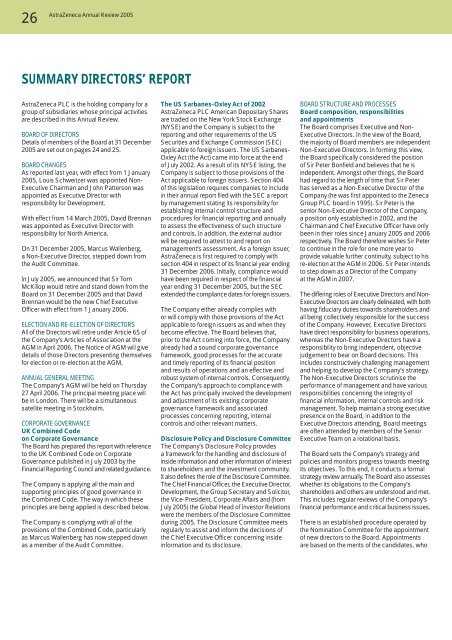AstraZeneca Annual Review 2005 - AstraZeneca Annual Reports
AstraZeneca Annual Review 2005 - AstraZeneca Annual Reports
AstraZeneca Annual Review 2005 - AstraZeneca Annual Reports
Create successful ePaper yourself
Turn your PDF publications into a flip-book with our unique Google optimized e-Paper software.
26<strong>AstraZeneca</strong> <strong>Annual</strong> <strong>Review</strong> <strong>2005</strong>SUMMARY DIRECTORS’ REPORT<strong>AstraZeneca</strong> PLC is the holding company for agroup of subsidiaries whose principal activitiesare described in this <strong>Annual</strong> <strong>Review</strong>.BOARD OF DIRECTORSDetails of members of the Board at 31 December<strong>2005</strong> are set out on pages 24 and 25.BOARD CHANGESAs reported last year, with effect from 1 January<strong>2005</strong>, Louis Schweitzer was appointed Non-Executive Chairman and John Patterson wasappointed as Executive Director withresponsibility for Development.With effect from 14 March <strong>2005</strong>, David Brennanwas appointed as Executive Director withresponsibility for North America.On 31 December <strong>2005</strong>, Marcus Wallenberg,a Non-Executive Director, stepped down fromthe Audit Committee.In July <strong>2005</strong>, we announced that Sir TomMcKillop would retire and stand down from theBoard on 31 December <strong>2005</strong> and that DavidBrennan would be the new Chief ExecutiveOfficer with effect from 1 January 2006.ELECTION AND RE-ELECTION OF DIRECTORSAll of the Directors will retire under Article 65 ofthe Company’s Articles of Association at theAGM in April 2006. The Notice of AGM will givedetails of those Directors presenting themselvesfor election or re-election at the AGM.ANNUAL GENERAL MEETINGThe Company’s AGM will be held on Thursday27 April 2006. The principal meeting place willbe in London. There will be a simultaneoussatellite meeting in Stockholm.CORPORATE GOVERNANCEUK Combined Codeon Corporate GovernanceThe Board has prepared this report with referenceto the UK Combined Code on CorporateGovernance published in July 2003 by theFinancial Reporting Council and related guidance.The Company is applying all the main andsupporting principles of good governance inthe Combined Code. The way in which theseprinciples are being applied is described below.The Company is complying with all of theprovisions of the Combined Code, particularlyas Marcus Wallenberg has now stepped downas a member of the Audit Committee.The US Sarbanes-Oxley Act of 2002<strong>AstraZeneca</strong> PLC American Depositary Sharesare traded on the New York Stock Exchange(NYSE) and the Company is subject to thereporting and other requirements of the USSecurities and Exchange Commission (SEC)applicable to foreign issuers. The US Sarbanes-Oxley Act (the Act) came into force at the endof July 2002. As a result of its NYSE listing, theCompany is subject to those provisions of theAct applicable to foreign issuers. Section 404of this legislation requires companies to includein their annual report filed with the SEC a reportby management stating its responsibility forestablishing internal control structure andprocedures for financial reporting and annuallyto assess the effectiveness of such structureand controls. In addition, the external auditorwill be required to attest to and report onmanagement’s assessment. As a foreign issuer,<strong>AstraZeneca</strong> is first required to comply withsection 404 in respect of its financial year ending31 December 2006. Initially, compliance wouldhave been required in respect of the financialyear ending 31 December <strong>2005</strong>, but the SECextended the compliance dates for foreign issuers.The Company either already complies withor will comply with those provisions of the Actapplicable to foreign issuers as and when theybecome effective. The Board believes that,prior to the Act coming into force, the Companyalready had a sound corporate governanceframework, good processes for the accurateand timely reporting of its financial positionand results of operations and an effective androbust system of internal controls. Consequently,the Company’s approach to compliance withthe Act has principally involved the developmentand adjustment of its existing corporategovernance framework and associatedprocesses concerning reporting, internalcontrols and other relevant matters.Disclosure Policy and Disclosure CommitteeThe Company’s Disclosure Policy providesa framework for the handling and disclosure ofinside information and other information of interestto shareholders and the investment community.It also defines the role of the Disclosure Committee.The Chief Financial Officer, the Executive Director,Development, the Group Secretary and Solicitor,the Vice-President, Corporate Affairs and (fromJuly <strong>2005</strong>) the Global Head of Investor Relationswere the members of the Disclosure Committeeduring <strong>2005</strong>. The Disclosure Committee meetsregularly to assist and inform the decisions ofthe Chief Executive Officer concerning insideinformation and its disclosure.BOARD STRUCTURE AND PROCESSESBoard composition, responsibilitiesand appointmentsThe Board comprises Executive and Non-Executive Directors. In the view of the Board,the majority of Board members are independentNon-Executive Directors. In forming this view,the Board specifically considered the positionof Sir Peter Bonfield and believes that he isindependent. Amongst other things, the Boardhad regard to the length of time that Sir Peterhas served as a Non-Executive Director of theCompany (he was first appointed to the ZenecaGroup PLC board in 1995). Sir Peter is thesenior Non-Executive Director of the Company,a position only established in 2002, and theChairman and Chief Executive Officer have onlybeen in their roles since January <strong>2005</strong> and 2006respectively. The Board therefore wishes Sir Peterto continue in the role for one more year toprovide valuable further continuity, subject to hisre-election at the AGM in 2006. Sir Peter intendsto step down as a Director of the Companyat the AGM in 2007.The differing roles of Executive Directors and Non-Executive Directors are clearly delineated, with bothhaving fiduciary duties towards shareholders andall being collectively responsible for the successof the Company. However, Executive Directorshave direct responsibility for business operations,whereas the Non-Executive Directors have aresponsibility to bring independent, objectivejudgement to bear on Board decisions. Thisincludes constructively challenging managementand helping to develop the Company’s strategy.The Non-Executive Directors scrutinise theperformance of management and have variousresponsibilities concerning the integrity offinancial information, internal controls and riskmanagement. To help maintain a strong executivepresence on the Board, in addition to theExecutive Directors attending, Board meetingsare often attended by members of the SeniorExecutive Team on a rotational basis.The Board sets the Company’s strategy andpolicies and monitors progress towards meetingits objectives. To this end, it conducts a formalstrategy review annually. The Board also assesseswhether its obligations to the Company’sshareholders and others are understood and met.This includes regular reviews of the Company’sfinancial performance and critical business issues.There is an established procedure operated bythe Nomination Committee for the appointmentof new directors to the Board. Appointmentsare based on the merits of the candidates, who




